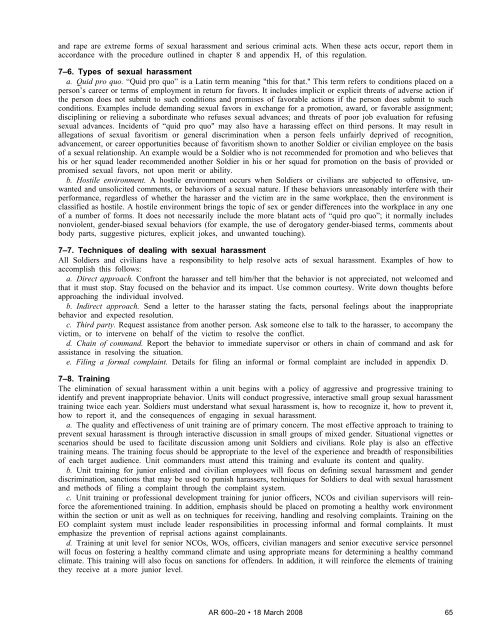AR 600-20, Army Command Policy - Army Publishing Directorate ...
AR 600-20, Army Command Policy - Army Publishing Directorate ...
AR 600-20, Army Command Policy - Army Publishing Directorate ...
You also want an ePaper? Increase the reach of your titles
YUMPU automatically turns print PDFs into web optimized ePapers that Google loves.
and rape are extreme forms of sexual harassment and serious criminal acts. When these acts occur, report them in<br />
accordance with the procedure outlined in chapter 8 and appendix H, of this regulation.<br />
7–6. Types of sexual harassment<br />
a. Quid pro quo. “Quid pro quo” is a Latin term meaning "this for that." This term refers to conditions placed on a<br />
person’s career or terms of employment in return for favors. It includes implicit or explicit threats of adverse action if<br />
the person does not submit to such conditions and promises of favorable actions if the person does submit to such<br />
conditions. Examples include demanding sexual favors in exchange for a promotion, award, or favorable assignment;<br />
disciplining or relieving a subordinate who refuses sexual advances; and threats of poor job evaluation for refusing<br />
sexual advances. Incidents of “quid pro quo" may also have a harassing effect on third persons. It may result in<br />
allegations of sexual favoritism or general discrimination when a person feels unfairly deprived of recognition,<br />
advancement, or career opportunities because of favoritism shown to another Soldier or civilian employee on the basis<br />
of a sexual relationship. An example would be a Soldier who is not recommended for promotion and who believes that<br />
his or her squad leader recommended another Soldier in his or her squad for promotion on the basis of provided or<br />
promised sexual favors, not upon merit or ability.<br />
b. Hostile environment. A hostile environment occurs when Soldiers or civilians are subjected to offensive, unwanted<br />
and unsolicited comments, or behaviors of a sexual nature. If these behaviors unreasonably interfere with their<br />
performance, regardless of whether the harasser and the victim are in the same workplace, then the environment is<br />
classified as hostile. A hostile environment brings the topic of sex or gender differences into the workplace in any one<br />
of a number of forms. It does not necessarily include the more blatant acts of “quid pro quo”; it normally includes<br />
nonviolent, gender-biased sexual behaviors (for example, the use of derogatory gender-biased terms, comments about<br />
body parts, suggestive pictures, explicit jokes, and unwanted touching).<br />
7–7. Techniques of dealing with sexual harassment<br />
All Soldiers and civilians have a responsibility to help resolve acts of sexual harassment. Examples of how to<br />
accomplish this follows:<br />
a. Direct approach. Confront the harasser and tell him/her that the behavior is not appreciated, not welcomed and<br />
that it must stop. Stay focused on the behavior and its impact. Use common courtesy. Write down thoughts before<br />
approaching the individual involved.<br />
b. Indirect approach. Send a letter to the harasser stating the facts, personal feelings about the inappropriate<br />
behavior and expected resolution.<br />
c. Third party. Request assistance from another person. Ask someone else to talk to the harasser, to accompany the<br />
victim, or to intervene on behalf of the victim to resolve the conflict.<br />
d. Chain of command. Report the behavior to immediate supervisor or others in chain of command and ask for<br />
assistance in resolving the situation.<br />
e. Filing a formal complaint. Details for filing an informal or formal complaint are included in appendix D.<br />
7–8. Training<br />
The elimination of sexual harassment within a unit begins with a policy of aggressive and progressive training to<br />
identify and prevent inappropriate behavior. Units will conduct progressive, interactive small group sexual harassment<br />
training twice each year. Soldiers must understand what sexual harassment is, how to recognize it, how to prevent it,<br />
how to report it, and the consequences of engaging in sexual harassment.<br />
a. The quality and effectiveness of unit training are of primary concern. The most effective approach to training to<br />
prevent sexual harassment is through interactive discussion in small groups of mixed gender. Situational vignettes or<br />
scenarios should be used to facilitate discussion among unit Soldiers and civilians. Role play is also an effective<br />
training means. The training focus should be appropriate to the level of the experience and breadth of responsibilities<br />
of each target audience. Unit commanders must attend this training and evaluate its content and quality.<br />
b. Unit training for junior enlisted and civilian employees will focus on defining sexual harassment and gender<br />
discrimination, sanctions that may be used to punish harassers, techniques for Soldiers to deal with sexual harassment<br />
and methods of filing a complaint through the complaint system.<br />
c. Unit training or professional development training for junior officers, NCOs and civilian supervisors will reinforce<br />
the aforementioned training. In addition, emphasis should be placed on promoting a healthy work environment<br />
within the section or unit as well as on techniques for receiving, handling and resolving complaints. Training on the<br />
EO complaint system must include leader responsibilities in processing informal and formal complaints. It must<br />
emphasize the prevention of reprisal actions against complainants.<br />
d. Training at unit level for senior NCOs, WOs, officers, civilian managers and senior executive service personnel<br />
will focus on fostering a healthy command climate and using appropriate means for determining a healthy command<br />
climate. This training will also focus on sanctions for offenders. In addition, it will reinforce the elements of training<br />
they receive at a more junior level.<br />
<strong>AR</strong> <strong>600</strong>–<strong>20</strong> 18 March <strong>20</strong>08<br />
65
















